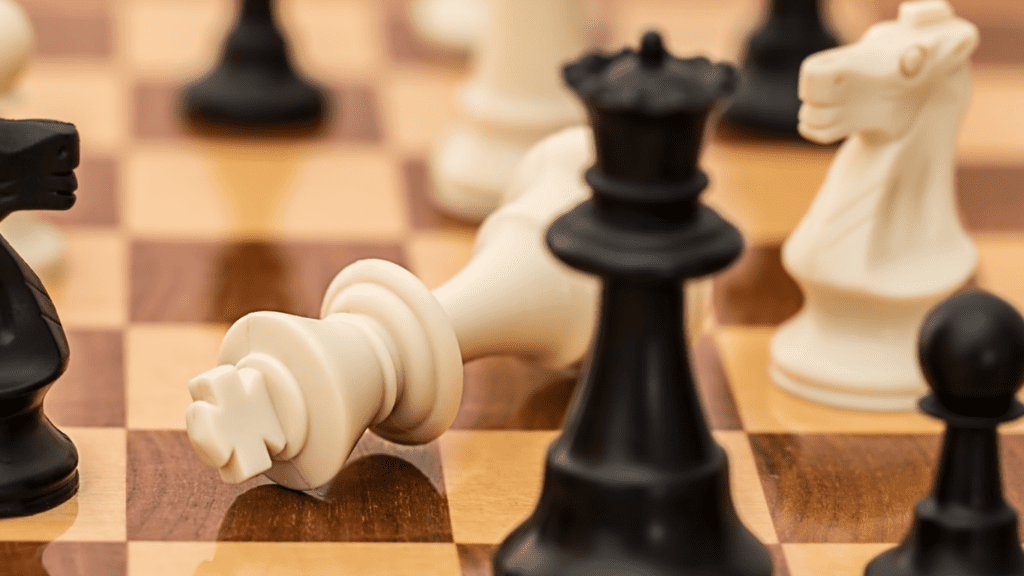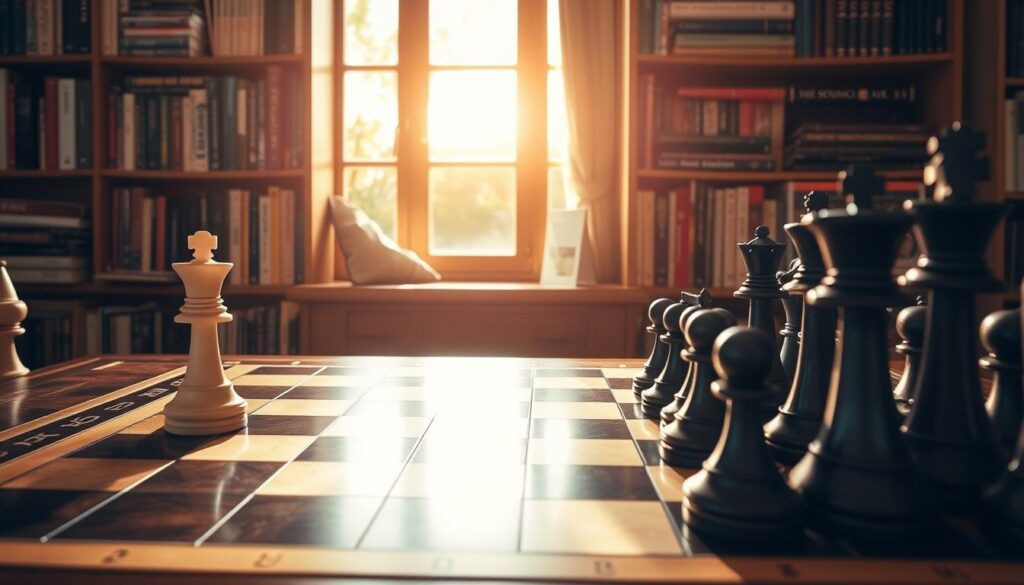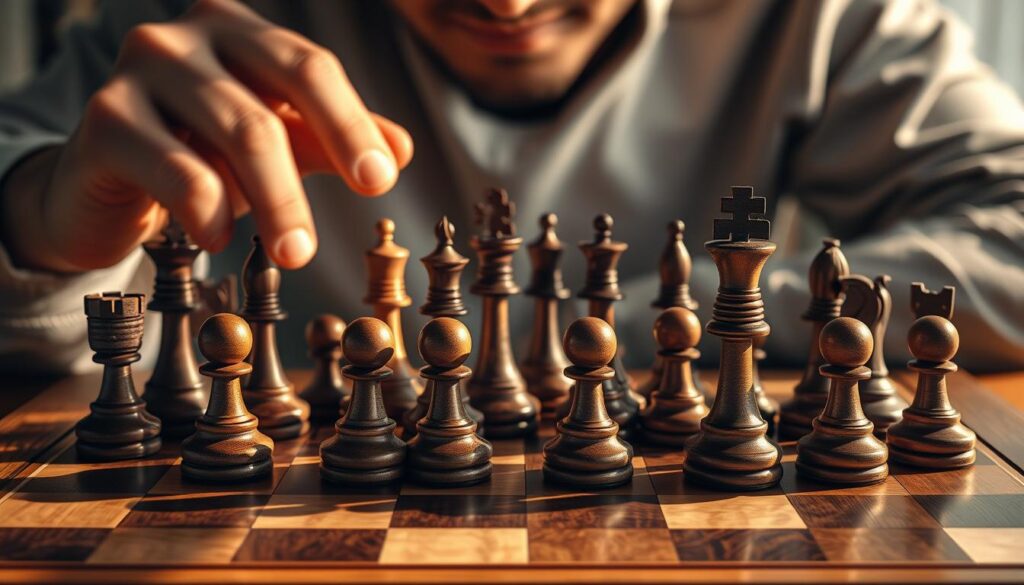
Learning to play chess can be a fun and rewarding hobby. It might seem overwhelming for beginners, but mastering the basics is key. Chess combines skill, strategy, and critical thinking, making it great for all ages.
Whether you play for fun or in tournaments, knowing the basics is crucial. It’s the first step to becoming a skilled player.

For new players, starting with the fundamentals is vital. You’ll learn the rules, about the pieces, and basic moves. As you get better, you’ll discover strategies and tactics to improve your game.
With practice and patience, anyone can learn to play chess. It offers many benefits, like better problem-solving and critical thinking skills.
Key Takeaways
- Mastering the basics of chess is essential for improving your game
- Understanding the rules and pieces is the first step to becoming a skilled player
- Beginner chess players should focus on developing their critical thinking and problem-solving skills
- Practice and patience are key to improving your chess skills
- Learning to play chess can be a fun and rewarding hobby for people of all ages
Understanding the Chess Board and Pieces
The game of chess is played on a chess board with 64 squares, in an 8×8 grid. To start, you need to know the board layout and the chess pieces. Each piece moves differently, which is key for making good moves.
At the start, each player has 16 pieces: one king, one queen, two rooks, two bishops, two knights, and eight pawns. Knowing how these pieces move is crucial for a strong strategy. For example, pawns can move forward one square, but two on their first move.
- King: The most important piece, as the goal is to protect it and checkmate your opponent’s king.
- Queen: The most powerful piece, able to move in any direction (horizontally, vertically, or diagonally) any number of squares.
- Rook: Can move horizontally or vertically, any number of squares.
- Bishop: Can move diagonally, any number of squares.
- Knight: Moves in an L-shape (two squares in one direction, then one square to the side).
- Pawn: Can move forward one square, but has the option to move two squares on its first move.
By learning about the chess board, chess pieces, and basic chess rules, you’ll build a strong chess foundation.
Basic Chess Moves and Rules
Learning the basic chess moves is key for beginners. Each piece moves differently. Pawns can go forward one or two spaces. Knights move in an L-shape. Bishops move diagonally, and rooks move horizontally or vertically.
The queen is the most powerful, moving in any direction. The king can move one space in any direction.
Understanding chess strategies means knowing the game’s rules well. Key concepts include check, checkmate, and stalemate. Check happens when a king is attacked and must be saved. Checkmate is when a king is attacked and can’t escape. Stalemate is when a player has no moves left and their king is not in check.
Here are some important chess basics to remember:
- Pawns can become any piece when they reach the other side of the board
- Castling lets the king move three spaces towards a rook, while the rook moves to the space the king crossed
- En passant is a special pawn capture that can be made under certain circumstances

By knowing these basic chess moves and rules, players can start to create their own chess strategies. Always think ahead and plan your moves carefully. The goal is to outmaneuver your opponent and keep your king safe.
Essential Chess Strategy for Beginners
Learning the basics of chess strategy is key for new players. It’s important to control the center of the board. This gives your pieces more room to move and attack.
Developing your pieces is also crucial. It lets you attack and defend better. This helps you control important squares and keep your king safe.
- Controlling the center of the board to gain mobility and flexibility
- Developing pieces to launch attacks and defenses
- Protecting the king to ensure safety and prevent checkmate
- Understanding basic pawn structure to influence the game’s dynamics
Mastering these strategies helps beginners improve their game. A good strategy is vital for success, whether you’re playing for fun or in tournaments. With time and practice, you’ll get better at chess strategy and enjoy the game more.
Common Chess Tactics and Combinations
Chess players use many tactics and combinations to beat their opponents. Chess tactics are short-term plans that help gain an edge. They include pins, forks, and skewers, which can attack the opponent’s pieces and make tough choices for them.
Knowing how to use these tactics well is key to chess strategy. By learning different chess combinations, players can get better and have more fun. For instance, a pin is when you attack a piece that’s defended by a more valuable one. This forces the opponent to move the defending piece, exposing the attacked one.
Some common chess tactics and chess combinations are:
- Pins: attacking an opponent’s piece that is defended by a more valuable piece
- Forks: attacking multiple opponent’s pieces at the same time, forcing them to choose which piece to save
- Skewers: attacking an opponent’s piece that is in front of a more valuable piece, forcing the opponent to move the attacked piece and exposing the more valuable piece
By using these chess tactics and chess combinations, players can build a strong
Mastering Your First Complete Chess Game
As you get better at chess, it’s key to know the game’s phases. A game has three main parts: the opening, middle game, and endgame. The chess opening starts the game, where players move their pieces and aim for the center. The middle game is about attacking and defending to get an edge. The chess endgame is the last part, where players try to win using their advantages.
To win your first game, learn the basics of each phase. Here are some important tips:
- Control the center with your pawns and pieces.
- Move your pieces fast and in a good order.
- Watch your pawn structure and piece placement.
Knowing the chess game phases helps you make smarter moves. As you play more, you’ll get better and win more games. The secret to winning is to stay focused and adjust to each game’s unique challenges.
Opening Principles
The opening is crucial for setting the game’s direction. By controlling the center and moving your pieces quickly, you’re on the path to success.
Conclusion: Taking Your Chess Skills to the Next Level
To get better at chess, you need to practice a lot and learn from your mistakes. It’s important to have a plan to improve, like studying chess strategy and looking at games. This way, you’ll understand the game better and make smarter moves.
Some key areas to focus on for chess improvement include:
- Practicing tactics and combinations to enhance your chess skills
- Studying chess strategy and learning from master games
- Joining a chess community to connect with other players and learn from their experiences
As you keep improving, remember that it’s a never-ending journey. Stay motivated and keep pushing yourself to reach your goals. With hard work and determination, you can excel at chess and enjoy it even more.
By using what you’ve learned in this article, you’re on the path to becoming a great chess player. Always keep learning and stay focused on your goals. You’ll see big improvements in your chess skills over time.
Additional Resources for Chess Learners
As you keep playing chess, looking into more resources can really help you grow. You can find books, online courses, and join the chess community. These options can make your chess learning better.
Dive into the world of chess books, from old strategy guides to new, fresh ideas. Websites like Chess.com and Lichess.org have lots of free lessons and games. You can also join local chess clubs or online groups to meet other players and learn from them.
Keeping up with chess news, tournaments, and events can also boost your game. Being part of the chess community lets you see how grandmasters play. This can give you new ideas for your own games.
FAQ
What is the objective of the game of chess?
The goal of chess is to checkmate your opponent’s king. This means the king has no way to move and avoid capture.
How many squares are on a standard chess board?
A standard chess board has 64 squares. They are arranged in an 8×8 grid.
What are the names and starting positions of the chess pieces?
Chess pieces include the king, queen, rook, bishop, knight, and pawn. The pawns start on the second rank. The other pieces begin on the first rank.
What is the significance of controlling the center in chess?
Controlling the center is key in chess. It lets pieces move easily and put pressure on the opponent.
What is the purpose of piece development in chess?
Piece development moves pieces to better squares. It’s crucial for a strong position and effective attacks.
What is the difference between a tactic and a combination in chess?
A tactic is a single move that takes advantage of a weakness. A combination is a series of moves aimed at a goal, like checkmate.
How can a beginner player improve their chess skills?
Beginners can get better by practicing regularly. They should study openings and tactics. Analyzing games and joining competitions helps too. Getting advice from experienced players is also useful.



